Founder of the Lowell Museum, Moses Kimball | |
|---|---|
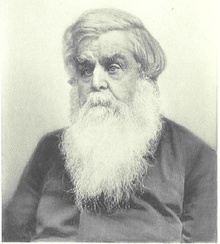 | |
The Lowell Museum, located in Lowell, Massachusetts, was founded by Moses Kimball in 1840, as an art exhibit hall and entertainment venue. [1]
Founder of the Lowell Museum, Moses Kimball | |
|---|---|
 | |
The Lowell Museum, located in Lowell, Massachusetts, was founded by Moses Kimball in 1840, as an art exhibit hall and entertainment venue. [1]
The Lowell Museum was housed on the upper floors of a building on Merrimack Street at the head of Central Street [2] owned by Lowell's U.S. Postmaster, Fisher Ames Hildreth, and the theatre venue of the museum was managed by N. F. Gates.
A bayonet accidentally wounded an actor called Wheeler above the eye during one of the performances on the evening of May 26, 1853, killing him instantly in front of a packed audience. [3]
In the mid-1850s, local artist Alfred Ordway was commissioned to paint portraits of all the presidents to adorn the museum. He finished in late 1855, only to lose them all in the fire.
According to the January 31, 1856 New York Times article, The Lowell Museum was destroyed by fire, at a loss of $15,000, which was partially insured. The fire destroyed the museum, several of the stores beneath it, including; C.W. Pratt dry goods, the Abel Whitney bookstore, R.B. Randall & Co. clothing store, and the Law Library of Benjamin Butler next door. The "Boston Nationals" who were performing in the museum's theatre managed by N.F. Gates, lost all of their costumes and belongings.

The Tremont Theatre (1827–1843) on 88 Tremont Street was a playhouse in Boston. A group of wealthy Boston residents financed the building's construction. Architect Isaiah Rogers designed the original Theatre structure in 1827 in the Greek Revival style. The playhouse opened on 24 September 1827.

The Chatham Theatre or Chatham Street Theatre was a playhouse on the southeast side of Chatham Street in New York City. It was located at numbers 143-9, between Roosevelt and James streets, a few blocks south of the Bowery. At its opening in 1839, the Chatham was a neighborhood establishment, which featured big-name actors and drama. By the mid-1840s, it had become primarily a venue for blackface minstrel shows. Frank S. Chanfrau restored some of its grandeur in 1848.

Niblo's Garden was a theater on Broadway and Crosby Street, near Prince Street, in SoHo, Manhattan, New York City. It was established in 1823 as "Columbia Garden" which in 1828 gained the name of the Sans Souci and was later the property of the coffeehouse proprietor and caterer William Niblo. The large theater that evolved in several stages, occupying more and more of the pleasure ground, was twice burned and rebuilt. On September 12, 1866, Niblo's saw the premiere of The Black Crook, considered to be the first piece of musical theater that conforms to the modern notion of a "book musical".

North Billerica is an unincorporated village of the town of Billerica, Massachusetts, United States, one of the nine sections (hamlets) that make up the Town of Billerica. It is the home to Faulkner and Talbot mills and the North Billerica Train Depot. The Middlesex Canal was built through the village in 1783 and the Boston and Lowell Railroad was put through in the 1840s.

The Tremont Temple on 88 Tremont Street is a Baptist church in Boston, affiliated with the American Baptist Churches, USA. The existing multi-storey, Renaissance Revival structure was designed by architect Clarence Blackall of Boston, and opened in May 1896. It replaced a much smaller, 1827 structure that had repeatedly suffered damage by fires.

The Howard Athenæum (1845–1953), also known as Old Howard Theatre, in Boston, Massachusetts, was one of the most famous theaters in Boston history. Founded in 1845, it remained an institution of culture and learning for most of its years, finally closing in 1953. It was demolished in 1962 after a fire in June 1961.

The Boston Museum (1841–1903), also called the Boston Museum and Gallery of Fine Arts, was a theatre, wax museum, natural history museum, zoo, and art museum in 19th-century Boston, Massachusetts. Moses Kimball established the enterprise in 1841.
The Columbian Museum (1795–1825) was a museum and performance space in Boston, Massachusetts, established by Daniel Bowen, and continued by William M. S. Doyle. The museum featured artworks, natural history specimens, wax figures, and other curiosities.
The Boston Theatre was a theatre in Boston, Massachusetts. It was first built in 1854 and operated as a theatre until 1925. Productions included performances by Thurlow Bergen, Charles A. Bigelow, Edwin Booth, Anna Held, James O'Neill Jennie Kimball, and others.
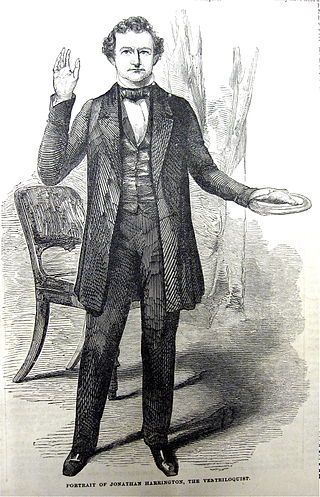
Jonathan Harrington (1811–1881) was a ventriloquist and illusionist in 19th century United States. He performed in Boston, Philadelphia, and elsewhere.

The Melodeon was a concert hall and performance space in 19th-century Boston, Massachusetts, located on Washington Street, near West Street. Musical concerts, lectures, sermons, conferences, visual displays, and popular entertainments occurred there.

The Haymarket Theatre (1796-1803) or Hay-Market Theatre was a theatre in late-18th century Boston, Massachusetts. Organized by Charles Stuart Powell, it occupied a large, wooden building "opposite the Mall on Common Street, near Hatch's Tavern." In addition to dramatic plays, the theatre presented some 62 musical entertainments during its first 5 years. The Haymarket "was seldom used after 1800, and on March 3, 1803, it was offered for sale at auction on the condition that it be removed in 60 days."
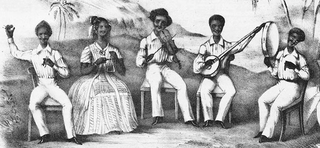
The Harmoneons were a blackface musical singing group in the 19th-century United States. The group began as the "Albino Family" in 1843, and later became the "Harmoneon Family." Principal group members included L.V.H. Crosby; Marshall S. Pike (1818-1901); James Power; and John Power Through the years others associated with the group included: F.B. Howe; Francis Lynch; W.H. Mower, manager; T.B. Prendergast; and F.A. Reynolds. In 1847 the Harmoneons performed for President James Polk at the White House. The group sang throughout the U.S., including Baltimore, Maryland ; Trenton, New Jersey (1847); Portsmouth, New Hampshire (1848); Lowell, Mass. (1849); Salem, Mass. (1849); Belfast, Maine ; and in Boston at the Melodeon (1849), Horticultural Hall, and other venues. They also toured in Halifax, Nova Scotia.

The Federal Street Theatre (1793–1852), also known as the Boston Theatre, was located at the corner of Federal and Franklin streets in Boston, Massachusetts, United States. It was "the first building erected purposely for theatrical entertainments in the town of Boston."

Brattle Street, which existed from 1694 to 1962, was a street in Boston, Massachusetts located on the current site of City Hall Plaza, at Government Center.
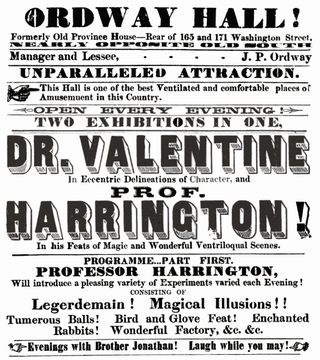
Ordway Hall (est.1852) was a theatre in Boston, Massachusetts located off Washington Street in the former Province House. John P. Ordway established and managed the hall, which specialized in "negro minstrelsy," particularly the Ordway Aeolians, his own troupe.

Tremont Row (1830s-1920s) in Boston, Massachusetts, was a short street that flourished in the 19th and early-20th centuries. It was located near the intersection of Court, Tremont, and Cambridge streets, in today's Government Center area. It existed until the 1920s, when it became known as Scollay Square. In 1859 the Barre Gazette newspaper described Tremont Row as "the great Dry Goods Street of Boston."
Theatre Comique (1865–1869) of Boston, Massachusetts, was located at no. 240 Washington Street. Personnel included Jason Wentworth, William H. Crisp, James S. Maffitt, George Maffitt, B.F. Lowell, Wm. H. Daly, orchestra leader Aug. Muller, and maitre de ballet Signor Constantine. Among the performances: slack rope and acrobatics by Martini Chiriski and the Levantine Brothers; Mlle. Augusta, danseuse; "Aladdin" with Kate Pennoyer and W.H. Bartholomew; dancing by Betty Regl; Snow Brothers ; Morlacchi Ballet Troupe; Wilson Brothers ; Ada Harland; and Jarrett & Palmer's "Forty Thieves." It occupied the building formerly known as Andrews Hall, Barnum's Aquarial Gardens, and the Boston Aquarial and Zoological Gardens. In 1869 the theatre was renamed the "Adelphi Theatre."

The National Theatre (1836-1863) was a theatre in the West End of Boston, Massachusetts, in the mid-19th century. William Pelby established the enterprise in 1836, and presented productions of "original pieces, and the efforts of a well selected stock company, which, with few exceptions, have been American. The scenery is of the highest order, and the business of the stage well directed. Mr C.A. Eaton made his debut at this theatre, and here Mr. F.S. Hill's early labors were eminently successful. Mr. J.S. Jones has written and produced on this stage thirty pieces, embracing every department except tragedy." William Washburn designed the building, erected on the site of the former Warren Theatre. Performers at the National included Edwin Adams, Marietta Zanfretta, Jean Margaret Davenport, Julia Dean, Jonathan Harrington, W.H. Smith, Mary Ann Vincent, and Billy Whitlock. In 1852 the theatre burnt down, and was rebuilt. In 1863 the building was again destroyed by fire.
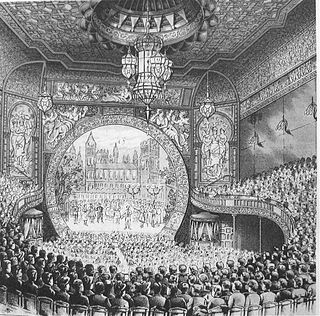
The Bijou Theatre (1882–1943) in Boston, Massachusetts, occupied the second floor of 545 Washington Street near today's Theatre District. Architect George Wetherell designed the space, described by a contemporary reviewer as "dainty." Proprietors included Edward Hastings, George Tyler, and B.F. Keith. Around the 1900s, it featured a "staircase of heavy glass under which flowed an illuminated waterfall." The Bijou "closed 31 December 1943 and was razed in 1951." The building's facade still exists. It is currently a pending Boston Landmark by the Boston Landmarks Commission.